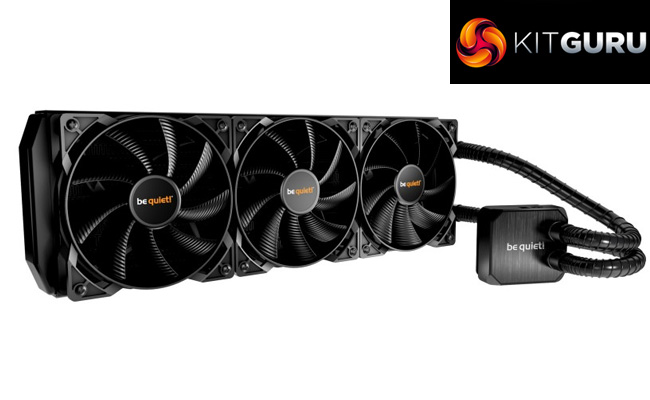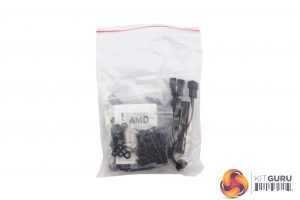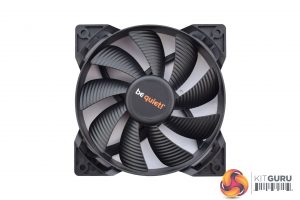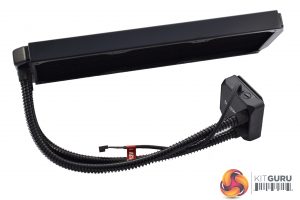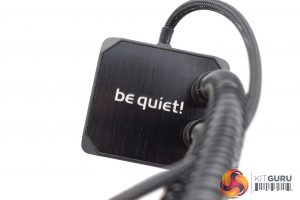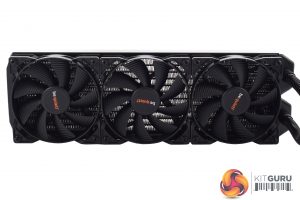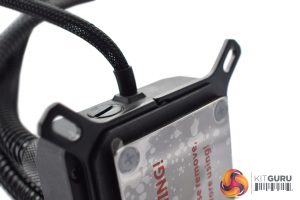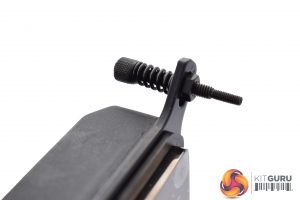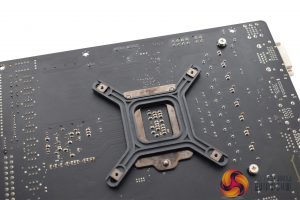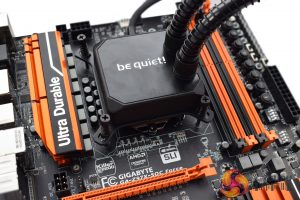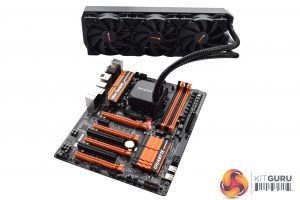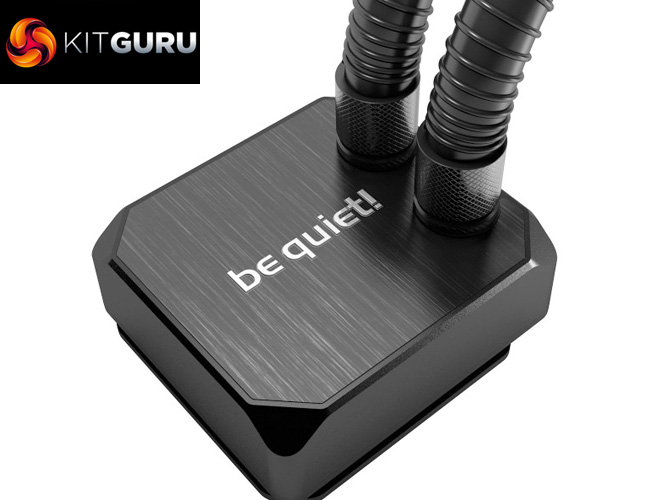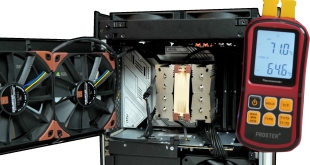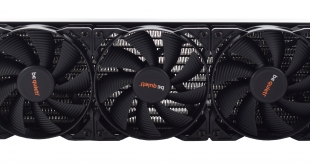
We previously looked at the be quiet! Silent Loop 240 at launch last year, but now there is a new kid on the block – the Silent Loop 360. It will be particularly interesting to assess the new 360mm unit as we have just finished testing the Alphacool Eisbaer 360 – and Alphacool also manufactures the Silent Loop series, so any similarities will be closely examined.
Given we were pretty happy with the Silent Loop 240 when we reviewed it last year, it will be interesting to see if be quiet! has changed anything with the Silent Loop 360. Read on for a full examination of the installation process, cooling performance and acoustics.
Specification
- Model: 360mm
- Dimensions radiator, incl. fan (H x W x D), (mm): 397 x 124 x 55
- Maximum power capacity (W TDP): 450
- Pump Type: Reverse Flow Pump
- Pump Speed: 2,200
- Pump Connector: 3 Pin
- Radiator Dimensions: 397 x 124 x 30
- Radiator Material / Finish: copper / black spray painted
- Base Material / Finish: copper / dark nickel plated
- Fan dimensions (mm) / Quantity (pcs.): 120 x 120 x 25 / 3
- Noise level (dB(A)) @ 25 % / 50% /100% rpm: 16.1 / 23.8 / 36.9
- Speed @ 100% PWM (rpm) : 2,000
- Airflow @ 12V (cfm / m3/h): 65.51 / 111.3
- Air pressure @ 12V (mm / H2O): 2.23
- Bearing type: Rifle
- Motor technology: 4-pole fan motor
- Connector: 4-pin PWM
- Lifespan (h / 25°C): 80,000
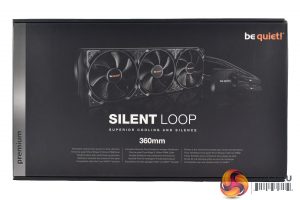
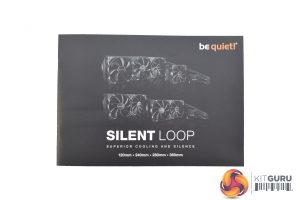
If you have ever owned a product from be quiet!, then the Silent Loop 360‘s packaging will no-doubt look familiar to you.
The installation manual also looks very similar and provides easy to understand instructions.
The actual installation hardware arrives in labelled bags, something regular readers will know I very much appreciate.
Three fans are included, and these are from the Pure Wings 2 family – be quiet! says they are specifically designed for radiators, so hopefully they will offer good performance and low noise levels.
The only thing left to look at is the cooler itself. It is all-black and obviously of the 360mm size, while the anti-kink tubing measures 39cm long. The radiator is also worth mentioning as it uses a full-copper core and measures 30mm thick.
The cooler as a whole is technically expandable, too, as it uses standard G1/4 threads and fittings. However, be quiet! does not advertise this very much and, unlike Alphacool, they don't sell add-on blocks or radiators so we would say that while expanding the Silent Loop 360 is certainly possible, it is not necessarily advisable.
Lastly, be quiet!'s pump/waterblock combo is also notable as it features a beautiful brushed-finish as well as the understated be quiet! logo. Just out of shot, but next to the 3-pin pump cable, is a small fill port as well – useful if you decide to remove the stock tubing or extend the loop.Here I will walk you through the installation process. It is worth noting we test using a Z97 motherboard – socket LGA 1150.
The process below reflects that.
It is also worth saying that the installation process is identical to Alphacool's Eisbaer 240 and Eisbaer 360 coolers – not surprising considering Alphacool is the OEM for the Silent Loop series.
The first thing to do is to screw the Pure Wings 2 fans to the radiator.
After that, the pump needs to be readied. First, attach the Intel mounting bracket – it comes in two separate pieces which lock together around the pump.
Next, place a spring and a washer over the four LGA 115x screws, pass the screws through the mounting bracket we just installed and secure each one with a small nut.
Before mounting the cooler, the Intel backplate needs to be positioned behind the motherboard's socket.
Then you can go ahead and mount the pump/waterblock to the CPU.
Once that is secure, installation is complete and it should look something like the photo above, right. The whole process is dead easy and won't take more that a couple of minutes.To test all CPU coolers, we devised an easily repeatable test with no variables other than the coolers themselves. This ensures that figures from every cooler we test are comparable with each other.
Test rig
Using an open-air test bench, we deploy an Intel Core i7-4790K plugged into a Gigabyte Z97X-SOC Force motherboard. Alongside this is 16GB of 2400MHz Corsair Vengeance DDR3, as well as a 120GB OCZ Trion 150 SSD. Powering everything is a Corsair RM750x PSU.
The test process
Testing coolers involves taking a total of 4 temperature readings per cooler. First, we measure the idle temperature of the i7-4790K at stock speeds (turbo boost disabled), before measuring its temperature under load at stock speeds. Next, we overclock the CPU to 4.5GHz using a 1.3 Vcore, ensuring greater heat output. In its overclocked state we then measure the idle and load temperatures of the CPU again. The figures we present are temperature deltas – meaning we take each temperature reading and minus the ambient temperature from it. This allows us to test in an environment that is not temperature-controlled.
To ward off potential comments or questions, we know 4.5GHz using a 1.3 Vcore is not the ‘best’ overclock – this particular CPU could reach that frequency at closer to 1.25 on the Vcore, which is more efficient. That is not the point, however. We are trying to stress the coolers to see how they deal with excess heat … hence the higher than necessary Vcore.
Where possible, each cooler’s fans are plugged directly into the motherboard using the CPU_Fan or CPU_Opt headers. Some AIOs, however, ship with their own fan controllers or PWM hubs. If we are unable to plug the fans directly into the motherboard, it is specified in the performance section of the review.
An idle reading comes from leaving Windows on the desktop for 15 minutes. A load reading comes from running Prime95’s (version 26.6) Small FFTs test for 15 minutes – enough time for temperatures to plateau.
Noise output
Unfortunately I am unable to properly measure the sound output of CPU coolers using a digital sound meter. This is because I am based alongside a busy road (with high ambient noise levels). Using a sound meter is, as such, not possible as there are variables out of my control. However, I will try my best to subjectively describe the noise output in a helpful manner.Temperatures
All temperature charts are sorted with lowest load temperatures at the top.
As we would expect from a cooler of this size, the Silent Loop 360 performs very well. It is just a couple degrees behind the Alphacool Eisbaer 360 across both tests, something likely down to the two products having different pumps and radiator fans. Still, being the 3rd most effective cooler we've tested to-date is not a bad achievement at all.
Acoustics
Given that be quiet!'s whole brand is about producing quiet products, it is no surprise that the Silent Loop 360 performs very well in this regard. Its fans are simply not audible when the system is idling, while the pump is just the faintest of whirrs in the background. At their max speed, the Pure Wings 2 fans can spin at 2000 rpm, which does become quite noticeable, but with a decent fan curve the unit is impressively easy on the ears.It is perhaps no surprise that we are scoring the be quiet! Silent Loop 360 the same as its smaller brother, the Silent Loop 240, as it is overall a very impressive product.
For starters, it is good-looking – I particularly like the brushed-finish to the pump/waterblock, while the Pure Wings 2 fans are similarly easy on the eyes.
Installation is also a doddle as the Silent Loop 360 uses the same method as Alphacool's Eisbaer liquid coolers and this means you will be up and running in no time.
Performance is just marginally worse than the Eisbaer 360, though, but that still means the Silent Loop 360 is very competitive. I would say it just edges the Eisbaer in the acoustics department, too, but neither cooler is loud enough for noise to be an issue.
So, overall, we are happy to recommend the be quiet! Silent Loop 360. It looks good, is easy to install and performs very well. Those looking to expand their loop down-the-line, or those just after the best raw performance figures, may want to look at the Alphacool Eisbaer 360 instead, but the Silent Loop 360 is still a very good option for those wanting a big liquid cooler.
You can buy one for £149.99 from Overclockers UK HERE.
Discuss on our Facebook page HERE.
Pros
- Good-looking.
- Easy to install.
- Very good performance.
- Easy on the ears.
- G1/4 fittings used.
Cons
- Alphacool's Eisbaer is easier to expand, and also cools marginally better.
KitGuru says: For those looking for a big-yet-beautiful liquid cooler, the Silent Loop 360 is a very good option to have.
 KitGuru KitGuru.net – Tech News | Hardware News | Hardware Reviews | IOS | Mobile | Gaming | Graphics Cards
KitGuru KitGuru.net – Tech News | Hardware News | Hardware Reviews | IOS | Mobile | Gaming | Graphics Cards


